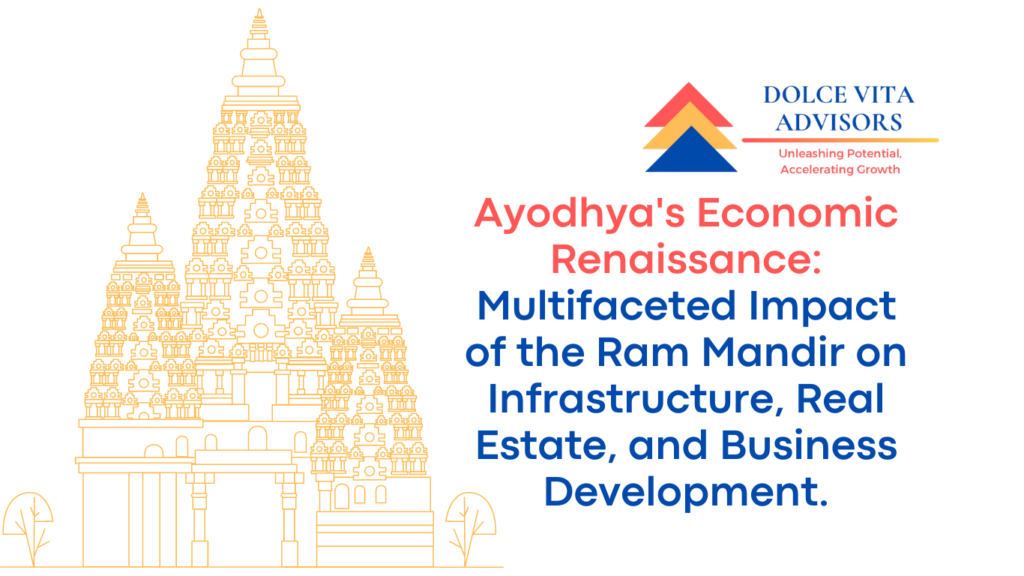
Insights by: Sumit Kochar
For centuries, Ayodhya has stood as a symbol of India’s rich religious and mythological heritage. However, the recent developments surrounding the construction of the Ram Mandir have not only infused spiritual fervor into this ancient town but also paved the way for a comprehensive economic and infrastructural renaissance. This transformation positions Ayodhya as a global city that seamlessly blends tradition with modernity.

Historical and Spiritual Significance
Ayodhya’s historical and spiritual significance has long attracted pilgrims and tourists alike. The groundbreaking for the Ram Mandir has given new impetus to Ayodhya’s prominence, marking a pivotal moment in India’s cultural tapestry. This spiritual awakening serves as a catalyst for the multifaceted development that is reshaping Ayodhya into a modern-day global city. It can be observed that in future not only it will turn into a global city but can also turn into a global spiritual centre like Mecca and Vatican City.
Infrastructure Development
A significant catalyst for Ayodhya’s metamorphosis is the substantial investment in infrastructure projects. Satellite photos from a decade ago compared to recent ones reveal an unparalleled surge in development, turning a once-small town into a globally acclaimed tourist attraction. The post-2017 period has seen rapid transformation and the major hand for the growth of Ayodhya is under the BJP’s Union government and State government, with an infusion of Rs. 32,000 crores, having a total of 264 projects. These projects encompass the construction of state-of-the-art roads, highways, green-field townships, and a international airport. The ambitious development projects are not merely infrastructural but are strategic steps to position Ayodhya as a global hub. The accelerated construction of the Ram Mandir has not only been a spiritual endeavor but has also catalyzed rapid infrastructure growth in its surroundings. To facilitate devotees from around the world in reaching the Ram Mandir, three distinct pathways have been developed in Ayodhya.
The first pathway stretches from Nyaya Ghat to Sugreev Kila, covering a distance of 5.77 kilometers, known as the Shri Ram Janmabhoomi path. The second pathway connects Naya Ghat to Hanuman Garhi and extends to the Ram Mandir, including an 850-meter Bhakti path. The third pathway, spanning 12.9 kilometers, runs from Saadatganj to Ram Janmabhoomi, referred to as the Ram Path. These pathways have replaced narrow lanes with encroachments, thanks to the cooperation of Ayodhya residents who willingly contributed portions of their land for the expansion. In these areas, a comprehensive infrastructure plan includes the construction of 5-layer multi-level parking structures to accommodate devotees. The State Tourism Department has also embarked on rejuvenation efforts for 37 selected religious sites in and around Ayodhya, allocating approximately Rs. 70 crores for the redevelopment of sites such as Janki Ghat, Bada Sthan, Dashrath Bhawan Mandir, and others.
Urban Revitalization
Ayodhya’s urban landscape is undergoing a remarkable rejuvenation. The development of Maharishi Valmiki International Airport, which stated when the State government transferred 318 acres of land by signing a lease with the Airports Authority of India, signifies a key development to connect Ayodhya with the rest of India.
Furthermore, a 65-km outer ring road is being constructed by the National Highways Authority of India to manage the increasing rush on the Lucknow-Gorakhpur highway. Expansion plans for Ayodhya Dham Junction railway station are underway, with additional platforms in Phase 1, hinting at future expansion.
In the context of Ayodhya’s transformative vision for redevelopment, the Master Plan 2031 outlines a commitment to long-term investments, foreseeing an expenditure of approximately Rs 85,000 crore over the next decade. This visionary plan extends across the Ayodhya Development Authority Area, covering an expansive 875 sq km. Encompassing the existing master-planned city area of 133 sq km and the core city spanning 31.5 sq km, the initiative aims for comprehensive infrastructure and tourism development.
With estimates projecting a future resident-to-tourist ratio of 1:10, Ayodhya is poised to emerge as a prominent pilgrimage and tourist hotspot. The planned greenfield township is set to integrate various facilities, including state guest houses, hotels catering to diverse preferences, and commercial complexes, addressing the multifaceted needs of visitors. Collaboration from 37 agencies of both the Central and State Governments is already underway to revitalize Ayodhya, backed by a substantial budget of Rs 31,660 crore.
Notably, the National Highways Authority of India is steering projects worth Rs 10,000 crore, while the State government is actively engaged in 34 projects valued at Rs 75,00 crore. Simultaneously, the development of the airport, railway, and highway is progressing as separate endeavors. These ambitious development and infrastructure projects align with eight overarching themes: Aesthetic Ayodhya, Clean Ayodhya, Efficient Ayodhya, Accessible Ayodhya, Experiential Ayodhya, Modern Ayodhya, Cultural Ayodhya, and Healthy Ayodhya. This thematic framework reflects a holistic approach, striving to shape Ayodhya into a city that not only embraces modernity but also safeguards and enriches its cultural and historical heritage.
Real Estate Boom
The real estate sector is experiencing an unprecedented boom, fueled by the completion of the Ram Mandir and the subsequent surge in pilgrimage tourism. Ayodhya’s residents, recognizing the potential economic windfall, have actively participated in the development process. Land prices have reached record highs, with the stamp and registration figures revealing a substantial increase in sale deeds. Private investors, including luxury hotel brands like Taj, Radisson, and ITC, are capitalizing on this boom, fostering the development of hotels and townships. Additionally, the Ayodhya Development Authority is actively engaged in the development of housing schemes covering approximately 80 acres of land. Simultaneously, the Uttar Pradesh Housing Department has inaugurated the “Nav Ayodhya” township project with a substantial budget of Rs. 3000 crores, spanning across 1,200 acres. This initiative is specifically tailored to meet the potential housing needs and preferences of senior citizens. The rationale behind these housing developments stems not only from the anticipated increase in visitor footfall but also from the expected rise in demand for second homes among retirees and NRIs. This emerging trend mirrors patterns observed in other sacred cities such as Haridwar, Puri, Madurai, and Rameshwaram.
Corporate Investments
Ayodhya’s economic resurgence has attracted the interest of FMCG companies and food service chains, strategically positioning themselves to cater to the anticipated surge in tourism. Companies like Bisleri International, Parleji and Coca-Cola are also focusing on setting up greenfield plants to meet the increased consumer demand.
Tourism
The hospitality, travel and tourism industry has already created up to 20,000 additional jobs to cater the consecration of the Ram Mandir and is expected to trigger a tourism boom, further solidifying Ayodhya’s economic powerhouse status.
It is expected to attract a minimum of 2 lakh pilgrims regularly, with special occasions drawing even larger crowds and projections of 4 crore annual visitors by 2031 have prompted major hotel chains to plan new properties, ranging from 5-star giants like Taj and Radisson to budget players like OYO. Ayodhya is poised to become a thriving pilgrimage and tourist hotspot, significantly impacting the business and overall economy of the entire region.
Conclusion
The construction of the Ram Mandir in Ayodhya is not merely a religious event but a transformative force that has set in motion a holistic revival of the town’s economic, infrastructural, and cultural landscape. With meticulous planning, substantial investments, and active participation from both the government and the private sector, Ayodhya is on the path to becoming a global city that seamlessly combines tradition with modernity, ensuring sustained prosperity for years to come.

